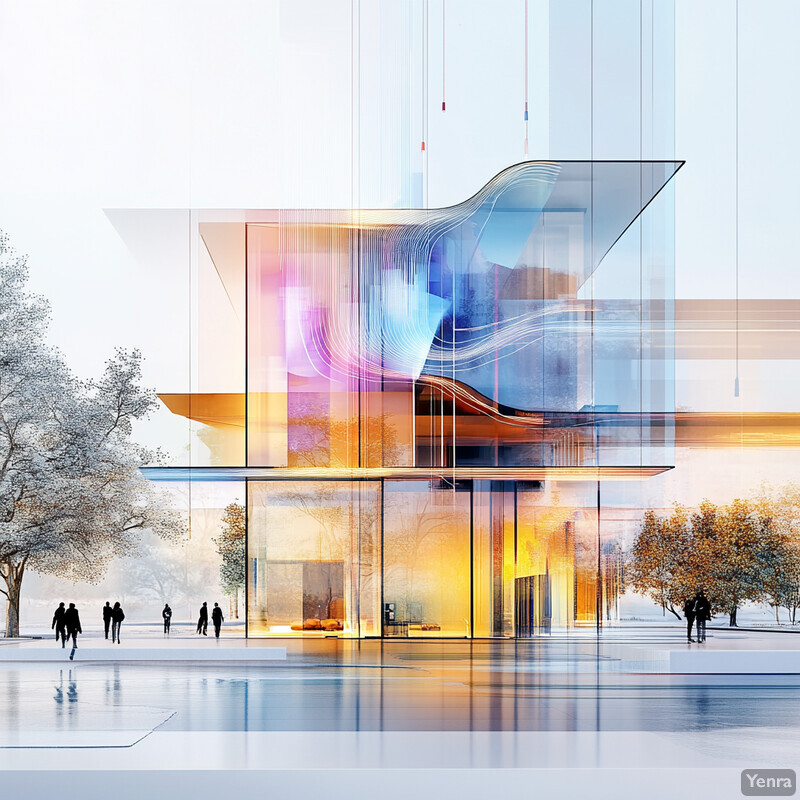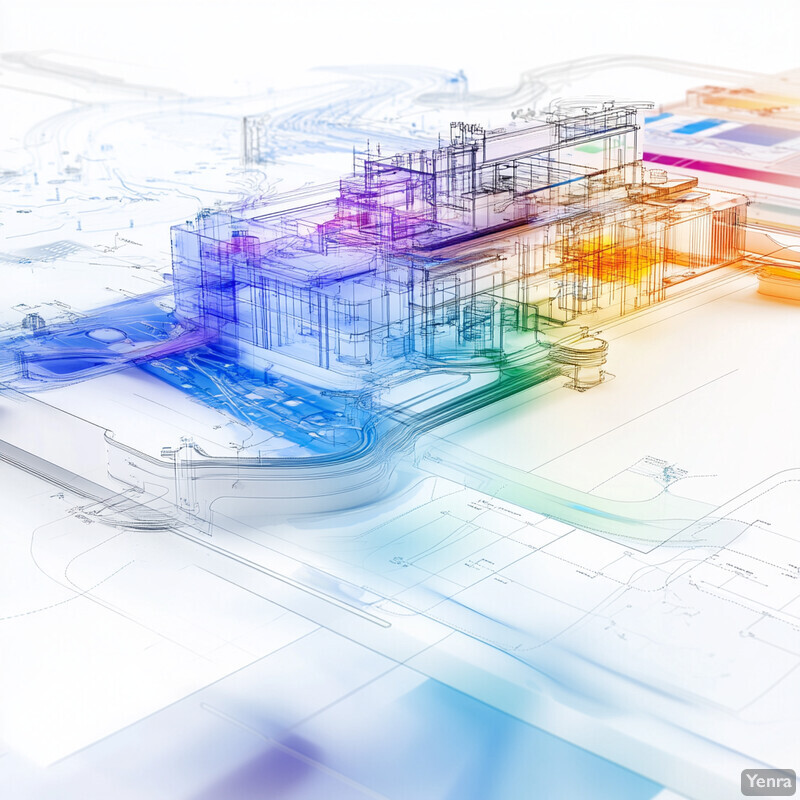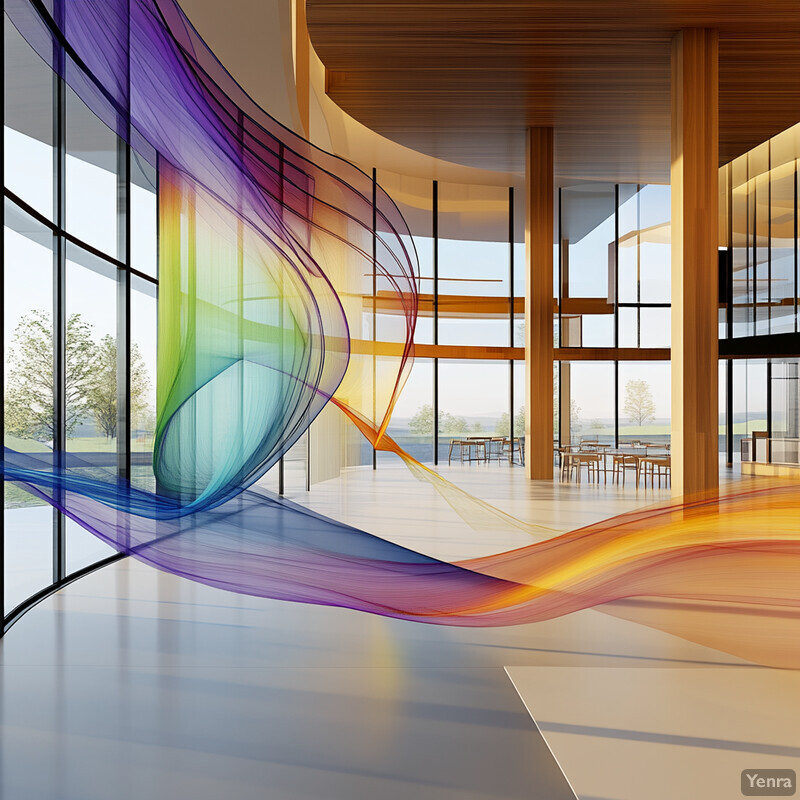Song: Architectural Design Simulation
1. Generative Design Alternatives
Generative design uses AI-driven algorithms to quickly explore a vast range of design options. By automating the creation of multiple building layouts or forms, these tools help architects evaluate many alternatives that would be time-consuming to produce manually. AI can optimize designs for various objectives (e.g. energy use or space efficiency) and adapt layouts based on constraints. This approach allows designers to compare options early in the process and refine concepts with data-driven feedback. Overall, AI-powered generative design augments the architect’s creativity by proposing innovative solutions and accelerating early-stage ideation.

AI-driven generative design systems leverage computational power to explore large design spaces and produce many alternatives. For example, Arowoiya and Onatayo (2024) describe generative design as an AI-driven approach that “leverages computational power to explore a vast design space and generate multiple design alternatives based on predefined constraints and objectives”. In practice, these algorithms can rapidly create design variants by adjusting inputs like massing, orientation, and program requirementsfrontiersin.org . Research shows that using generative design methods can significantly improve building performance: one study reported improvements in energy and thermal performance of about 23–28% compared to conventional designs. In one case study, generative tools produced large libraries of viable floor plans and helped identify solutions that met sustainability goals. As the AI learns from firm data and user feedback, its outputs become more aligned with desired outcomes. The result is a workflow where architects refine and select from a wider set of optimized design options than they could generate by hand.
2. Predictive Energy Modeling
Predictive energy modeling uses machine learning to estimate a building’s energy use early in design. Instead of running detailed simulation for every variant, AI models can quickly forecast energy consumption based on building parameters (shape, materials, systems). This gives designers fast feedback on how choices like insulation levels or glazing ratios will affect energy. By training on historical data or simulation results, these models can capture complex relationships among variables. The result is that architects can iteratively adjust the design with near-instant feedback on energy performance. Over time, this speeds up the optimization of building systems for efficiency and code compliance, reducing reliance on slower physics-based simulations in preliminary stages.

Studies show that machine learning (ML) models can predict building energy use with high accuracy, aiding decision-making in design. For example, Yin et al. (2024) developed ML models using features like building size and geometry to forecast primary energy consumption; they found ensemble methods (random forest, gradient boosting) “consistently outperform others in terms of prediction accuracy, robustness, and stability” for energy use. Their framework, applied to real Portland building data, highlights ML’s potential to quickly estimate energy demand from design inputs. Similarly, Kömürcü and Edis (2025) review ML models and note the goal of “prediction models that may assist the architects during the design process regarding the energy efficiency of buildings”. These predictive tools can provide designers with immediate estimates of heating and cooling loads given a building form, allowing for rapid “what-if” analysis. As Kömürcü and Edis summarize, ML energy models produce “fast and reliable results” so that architects can instantly see which design variables have the largest effect on energy and carbon. This enables real-time energy feedback in the iterative design workflow.
3. Automated Climate Analysis
Automated climate analysis uses AI to interpret local weather and environmental data for design guidance. Instead of manually compiling climate charts, AI tools can quickly analyze solar radiation, wind patterns, temperature ranges and other factors specific to the site. This informs decisions on building orientation, facade shading, and material choices. By integrating climate intelligence, AI can suggest passive strategies (e.g. window placement for daylight, optimized overhangs for sun control) from the outset. This acceleration of climate-informed design leads to buildings that naturally cope with local conditions, improving comfort and reducing energy use. In practice, it means designers can generate climate-adapted options or floor plans in minutes rather than days.

AI can encapsulate climate data into the design generation process so that solutions inherently respond to local conditions. For instance, Meselhy and Almalkawi (2025) describe “AI-driven energy-efficient floorplan generation” tools that address climate-driven energy challenges directly within urban design. They note these tools integrate design creation, performance evaluation, and optimization in a unified framework. This contrasts with traditional workflows that begin with manual climate analysis; the AI approach can bypass that step by producing climate-responsive designs automatically. In practice, Esri researchers demonstrate that CityEngine combined with generative AI can rapidly produce realistic urban design scenarios and test them with environmental metrics in real timeesri.com . Such tools allow architects to adjust building massing and immediately see effects on factors like sunlight, viewsheds, and zoning constraints. In one project, designers used AI visualization to compare multiple schemes and their climate impacts side-by-sideesri.com . By automating the integration of climate data, these workflows yield resilient designs without lengthy initial studies.
4. Material Selection Optimization
AI can automate the selection of building materials by evaluating performance and sustainability criteria. Instead of manually comparing dozens of options, AI tools analyze large databases of material properties (like strength, insulation, embodied carbon) and recommend choices that meet design goals. For example, an AI may score materials on environmental impact and cost and rank them for a given application. This speeds up the search for low-carbon materials or high-performance composites. In parametric design, the AI can even tweak mixtures (e.g. concrete admixtures) to meet strength or fire-resistance targets. The result is more data-driven material decisions and quicker convergence on optimal solutions.

Research indicates AI frameworks can handle complex material data to suggest optimal choices for architects. Shamim et al. (2025) note that combining AI and regression models can significantly increase accuracy of construction cost estimates and implicitly material selection by analyzing many project factors. More directly, Luo et al. (2025) review AI in concrete design, reporting that techniques like XGBoost and ensemble models achieve high accuracy (R²≈0.93) in predicting material performance. These AI models can predict how varying mix proportions affect properties like strength and workability, enabling automated material optimization. Another approach is knowledge reuse: for example, Skema’s BIM software automatically incorporates a firm’s past design data (“BIM knowledge reuse engine”) so materials and details that performed well previously can be proposed in new designsarchitosh.com . Overall, AI-driven analysis helps architects evaluate many material options in terms of structural performance, durability, and sustainability faster than traditional methods.
5. Airflow and Ventilation Modeling
AI models can simulate airflow patterns in buildings to aid natural ventilation design. Instead of running complex computational fluid dynamics (CFD) every time, machine learning surrogates can predict how air will move through a floor plan given window positions and room geometry. Designers can thus get instant feedback on drafty areas or stagnant zones. AI can also optimize ventilation layouts for peak performance (e.g. placing ducts or openings for best airflow). During design, this means easily testing how changes (like adding skylights or fans) affect airflow. In HVAC planning, AI can fine-tune system parameters for airflow balance. Overall, AI-accelerated airflow analysis speeds up the ventilation design process and helps ensure healthy indoor air without repeated manual calculations.

Research on ventilation networks suggests that AI can greatly speed modeling and control of complex airflows. For example, Semin and Kormshchikov (2024) review AI in mine ventilation and observe that machine learning and evolutionary algorithms enable “enhanced monitoring and control of air parameter distribution” and can quickly reconstruct airflow patterns under various conditions. Likewise, recent developments in neural operator models show that AI can predict fluid flows in milliseconds. One study found that a deep learning “neural operator” could predict entire 3D airflow fields instantaneously, whereas traditional CFD would take hours. These advances imply that, once trained, AI models can give architects near-instant predictions of indoor airflow distributions as design parameters change. This allows real-time evaluation of ventilation strategies (such as natural cross-ventilation or duct layouts) during design, with accuracy comparable to detailed simulationsresearchgate.net .
6. Structural Performance Prediction
AI can predict structural behavior (stresses, deflections, stability) to inform engineering decisions. By training on data from simulations or experiments, AI models (like neural networks) can quickly estimate how a structure will respond to loads. For instance, an AI tool might predict beam bending or how a truss deforms under weight without running a finite element analysis. This helps validate design choices early. AI can also flag potential issues (overstress, buckling risk) across many design variants. By delivering near-instant structural feedback, architects can iterate on forms while staying mindful of safety and performance constraints. This accelerates the integration of structural analysis into the design loop, enabling more creative shapes with confidence.

AI and machine learning have shown promise in forecasting material and structural responses. Luo et al. (2025) discuss how ML models (e.g. random forests, gradient boosting) can achieve high accuracy in predicting concrete properties like strength, which are critical for structural design. Beyond materials, advanced neural network approaches (such as physics-informed or graph neural networks) are being developed to predict stress and strain in complex structures. For example, research in computational mechanics shows that once trained, a neural model can predict full-field stress and deformation quickly, effectively capturing nonlinear phenomena (like plasticity). Although much of this work is early-stage, the results indicate AI can accelerate structural analysis. By using these models as surrogates, designers can explore more configurations; for example, rapidly estimating how changing a support location affects load distribution, without waiting for repeated finite-element runs. This integration of AI makes it feasible to include structural feedback in conceptual design in real time.
7. Rapid Life Cycle Assessments (LCA)
Rapid LCA uses AI to quickly estimate environmental impacts (like embodied carbon) of a design. Normally, calculating LCA involves detailed material inventories and software. AI can speed this up by learning from existing LCA databases and design parameters. Designers can input a schematic (or key material choices) and instantly get approximated whole-life carbon and energy use. This helps compare options like concrete vs. timber or glazing vs. wall area on the fly. As the design evolves, the model updates impact estimates, enabling eco-friendly decisions early. The result is seamless inclusion of sustainability metrics in the workflow, rather than leaving LCA until late stages.
-3.jpg)
Integrating LCA into design with AI has been demonstrated in recent research. Salgado et al. (2025) present a case where machine learning is combined with LCA data to optimize building material design. They incorporate global warming potential (GWP) as an objective alongside structural goals, using ML to find designs that reduce carbon impact. Their approach effectively “bridges the gap” by training AI models on past material data and using LCA outputs (e.g. GWP) as feedback, allowing simultaneous optimization of performance and environmental impact. Similarly, Shamim et al. (2025) review shows AI models can automatically process project inputs to predict costs and, by extension, perform automated life-cycle estimations, achieving higher accuracy than traditional methods. In practice, these tools let architects tweak designs (like material quantities) and immediately see both performance and LCA outcomes, making rapid sustainability analysis part of the design iteration.
8. Acoustic Simulation and Optimization
AI can help predict and shape room acoustics by learning from acoustic models. Instead of running lengthy simulations for every layout, AI tools can estimate reverberation time, sound levels, and speech intelligibility based on room geometry and material choices. Designers could sketch a room or specify materials and have the AI immediately indicate acoustic performance, highlighting echo hotspots or suggesting absorptive treatments. This enables quick evaluation of different configurations (like ceiling tiles or wall panels) for optimal acoustics. By integrating acoustics early, spaces are better tuned for use (offices, auditoriums, etc.) without trial-and-error. AI also enables optimization: for example, iteratively adjusting wall shapes or furnishings to minimize noise. The outcome is efficient collaboration between architects and acousticians.

Recent work highlights AI’s role in acoustical design. Starowicz and Zieliński (2024) review “sustainable acoustics” and note that AI-driven techniques enable architects to analyze parameters and materials to achieve ideal acoustic properties. They emphasize that AI can assist in noise reduction and managing soundscapes by incorporating large acoustic datasets. For instance, one can use an AI model to predict how changing wall finishes or adding diffusors will affect reverberation. These tools can even adapt designs in real time: if a designer moves a wall in the model, the AI instantly updates the acoustic metrics. By automating such simulations, architects can explore more sound design options efficiently. As the review notes, AI methods “enhance the prediction of building energy consumption and the recognition of occupant’s thermal comfort,” and similarly they improve acoustic comfort by rapidly evaluating sound-related outcomesresearchgate.net .
9. Thermal Comfort Modeling
AI-based thermal comfort models predict how occupants will feel in different conditions. Traditional models use fixed equations (like PMV) that don’t account for individual or dynamic factors. AI models learn from sensor data (temperature, humidity, occupancy) to forecast comfort more accurately. For example, an AI could use real-time readings and historical preferences to adjust HVAC settings. This allows designers to simulate how changes (window placement, ventilation, thermal mass) will actually impact occupant comfort. During design, it means the ability to optimize spaces for comfort (and energy use) with responsive algorithms. Overall, AI-driven comfort models support adaptive control strategies, making buildings automatically maintain pleasant conditions as people move and weather changes.

Reviews highlight the need for adaptive comfort models and the role of AI. Ahsan et al. (2024) observe that current HVAC controls often rely on static comfort equations and call for AI models trained on large sensor datasets for real-time comfort prediction. They note that an effective AI-based comfort control “requires big data” and should be integrated with building systems to adjust conditions dynamically. Similarly, Li et al. (2020) (cited in their review) showed that ML models can predict occupants’ thermal sensation with around 80% accuracy by learning from environment and personal factors. In practice, this means using an AI model to continuously calibrate setpoints or suggest design changes: for instance, the model might learn that certain areas overheat and recommend extra shading. By providing comfort feedback instantly during design iterations, these AI models help architects balance energy efficiency with human well-beingmdpi.com .
10. Parametric Sensitivity Analysis
Parametric sensitivity analysis involves varying design parameters to see their effect on performance. AI accelerates this by using surrogate models or sensitivity algorithms. Once an AI model of building performance is trained, it can rapidly evaluate how small changes (like building orientation or insulation thickness) alter outputs (like energy or daylight). This helps identify which parameters have the largest impact. Designers can then focus on the most critical variables. By providing instantaneous feedback on parameter changes, AI tools enable a more guided exploration of design space. This approach informs decisions on where to invest effort, streamlining optimization of form and systems.

Machine learning models can enable instant sensitivity analysis by revealing the influence of design variables on performance. Kömürcü and Edis (2025) note that ML predictive models allow architects to quickly identify which factors most affect building energy and carbon footprint. In their review, these fast predictive models provided “immediate feedback on energy and carbon” so designers could see, for example, that adjusting window-to-wall ratio had a much larger effect on energy than changing roof insulation. This capability effectively automates a sensitivity study: by running the AI model with different inputs, one can estimate each parameter’s effect. For instance, an AI tool might instantly show that a 10% change in glazing yields a significant temperature swing, signaling a focus area for design refinement. In summary, AI-driven sensitivity analysis helps architects understand the relative importance of parameters with minimal computation, guiding more effective design iterations.
11. Cost Estimation and Budget Alignment
AI can automate early cost estimating by analyzing design parameters and historical cost data. Instead of a manual takeoff, AI models learn the relationships between design quantities (like volume, finishes, site conditions) and costs. When an architect sketches a building plan, the AI can immediately approximate material and labor costs. As the design changes, the model updates the estimate in real time, flagging potential overruns. This keeps design aligned with the budget without waiting for a quantity surveyor. Additionally, AI can include uncertainty and market trends (e.g. material price volatility) to refine estimates. The outcome is a more informed early design process where architects have continual visibility of cost implications.

Recent systematic reviews report that AI models significantly improve cost prediction accuracy and speed. Shamim et al. (2025) found that deep learning and hybrid models achieve on average 85–90% accuracy in cost estimation, far outperforming linear regression. They highlight that AI-driven approaches enable “real-time adjustments” and can process large volumes of project data to refine predictions. The study notes AI techniques like gradient boosting and neural networks have revolutionized cost modeling by identifying complex patterns in historical datamdpi.com . In practice, this means a design tool can analyze the current floor plan and predict costs for concrete, steel, finishes, etc., almost instantly. The AI can also incorporate feedback as the project evolves, so that changing a material or area immediately reflects on the budget. By integrating these models, architects can align their schemes with financial targets from the outset, reducing surprises later in the processmdpi.com .
12. Occupant Behavior Modeling
AI can simulate how people will use and move through a building. By learning from occupancy sensor data and behavioral studies, AI models predict patterns like room usage, window opening, or lighting preferences. Architects can use these models to estimate peak loads or comfort impacts. For example, AI might predict crowd flow in a lobby or how different user scenarios affect HVAC demand. This leads to designs that better accommodate actual use. By incorporating user behavior, the design process becomes more responsive – for instance, an AI might flag that a proposed workspace layout will create congestion and suggest a reconfiguration. This data-driven understanding of occupant habits helps optimize layouts and systems.

Research shows AI can robustly capture the uncertainty of human actions in buildings. Yan et al. (2023) review AI in occupant behavior and conclude that AI-based techniques are “highly robust in addressing the uncertain and unpredictable characteristics of occupant behavior” compared to traditional methods. They observe that ML approaches improve prediction of building energy use and thermal comfort by learning from data. For instance, neural networks have been trained to predict occupancy levels or window-opening behavior with reasonable accuracy, enabling better load forecasting. In practice, this means an AI model can, during design, estimate how typical users will adjust shading or thermostats and immediately reflect those effects in performance simulations. By iteratively including these adaptive behaviors, architects can design systems and spaces that better match real-world use, improving both efficiency and occupant satisfaction.
13. Resilience and Disaster Preparedness Modeling
AI helps model building and infrastructure resilience to disasters. For example, machine learning can predict how an earthquake or flood will damage a proposed design by learning from past disasters. During design, this means being able to simulate disaster scenarios quickly and adjust structural or site features for safety. AI can also optimize evacuation or shelter designs by simulating human movement during emergencies. On the urban scale, AI can analyze risk factors (like flood maps) and suggest adaptive strategies (raising foundations, green infrastructure). The advantage is that architects can test and improve the disaster-readiness of designs without needing to be experts in risk modeling.

AI-based tools for disaster risk assessment are emerging but still data-driven. Ghimire et al. (2023) demonstrate that machine learning models can predict seismic building damage using features like construction type and intensity measures. They note that ML-based predictions provide “damage estimates using a more cost-effective way” because they use readily available data rather than extensive surveys. While these models often rely on region-specific data (so accuracy depends on local construction practices), they are useful for rapid assessments. For instance, a model could flag that a particular massing or material choice leads to higher vulnerability under certain hazards. By integrating such AI predictions, architects can adjust designs to mitigate risks (e.g. adding bracing, choosing materials) early on. Though still a developing field, these methods allow resilience considerations to enter the design process efficiently.
14. Metadata Extraction and Knowledge Reuse
AI can automatically extract metadata (properties, dimensions, parameters) from design drawings or models. For example, it might read a floor plan and identify room types or material quantities. This populates BIM databases with detailed information without manual entry. AI can also match new projects with past ones by recognizing similar modules or layouts. In effect, knowledge reuse lets an AI suggest proven solutions from previous designs. As a result, architects can leverage their entire portfolio: if an AI knows a certain window detail worked well before, it might recommend it. This reuse of past design intelligence increases efficiency and consistency across projects.

AI systems are already being trained on firms’ historical data to support design reuse. ArchiLabs and others describe platforms where an AI assistant is fine-tuned on a firm’s past projects. For instance, SKEMA’s “AI-driven BIM” uses a firm’s existing BIM models as training data to generate new conceptual designs. As ArchiLabs reports, SKEMA “explicitly reuses firm-specific BIM data,” making the AI “smarter” with each project. Frausto-Robledo (2024) highlights that SKEMA effectively turns past BIM work into inputs for new designs, calling it a “BIM knowledge reuse engine”architosh.com . In practice, such AI can automatically pull relevant details (like standard unit plans or detailing) from the firm’s database when sketching a new project. This means metadata and institutional knowledge are recycled – saving time on detailing and ensuring best practices carry forward.